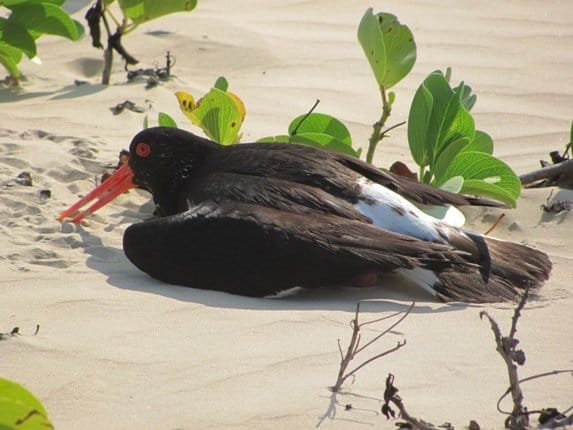We are into the second attempt at breeding for this season in Broome for Pied Oystercatchers. The first eggs are laid during the first week of July each year and if these eggs fail to hatch or the chicks are lost they will lay further eggs within a few weeks. We had one pair attempt 5 times in 2009, so they don’t give up easily! Sadly a lot of eggs are lost to feral cats and chicks are sometimes taken by birds of prey. If the parents chase the bird they may drop the chick, but from a great height this is a fatal injury.
I was soon on the beach after returning home to see the amazing white egg that had been laid by an old friend. This bird was originally banded in Roebuck Bay in 2002 and has used Cable Beach to nest for at least 12 years. She successfully raised a chick in 2007, which has been living in a large flock to the south of Broome. This week the chick did return to Cable Beach, which is very interesting….what happens next!? Is it returning to it’s birth place to look at establishing a territory for next year or just out to look for a mate? Time will tell! Her partner from 2007 has disappeared and she is currently with a new mate, which was also caught and banded in 2002 on the same day….so they are old friends!
Nest site with 3 eggs-one white!
I knew the eggs would have hatched out over the weekend and the next move would be a long walk. These parents have a strategy where they nest away from the reef and then walk the chicks the 2 kilometres there within a few days of hatching. I soon found the footprints and headed south towards the reef. I soon established that there were only 2 chicks left by day 3. This is not uncommon as they normally only lay 2 eggs and even the survival rate of 2 chicks beyond a few days is unusual.
Adult and 2 chicks footprints-hermit crabs make the other tracks!
I have very rarely had a broken wing display from Pied Oystercatchers over the years, as I keep my distance to observe them. This was not to be this time due to the terrain. I went over a dune following tracks and I suddenly l was within 2 metres of the parents. I tried to sit down, but they had seen me and immediately warned the chicks of danger by calling vocally. I took the opportunity to photograph the display as I made a retreat. I had to be very careful as I did not want to stand on any camouflaged chicks.
Broken wing display
I soon discovered the chicks hiding in the undergrowth and took a photo of each as I retreated. It is interesting how the patterns in the chick’s feathers are unique.
Three day old Pied Oystercatcher chicks
I have returned to observe this family from a distance and they are keeping themselves on higher ground this week due to the 10 metre tides we are experiencing.
The broken wing display is to convince any predator that they are injured and should be followed. They will move away from the chicks to distract the predator and I have seen it work very well with dogs!


















This is terrific, Clare. I love those camouflaged chicks!